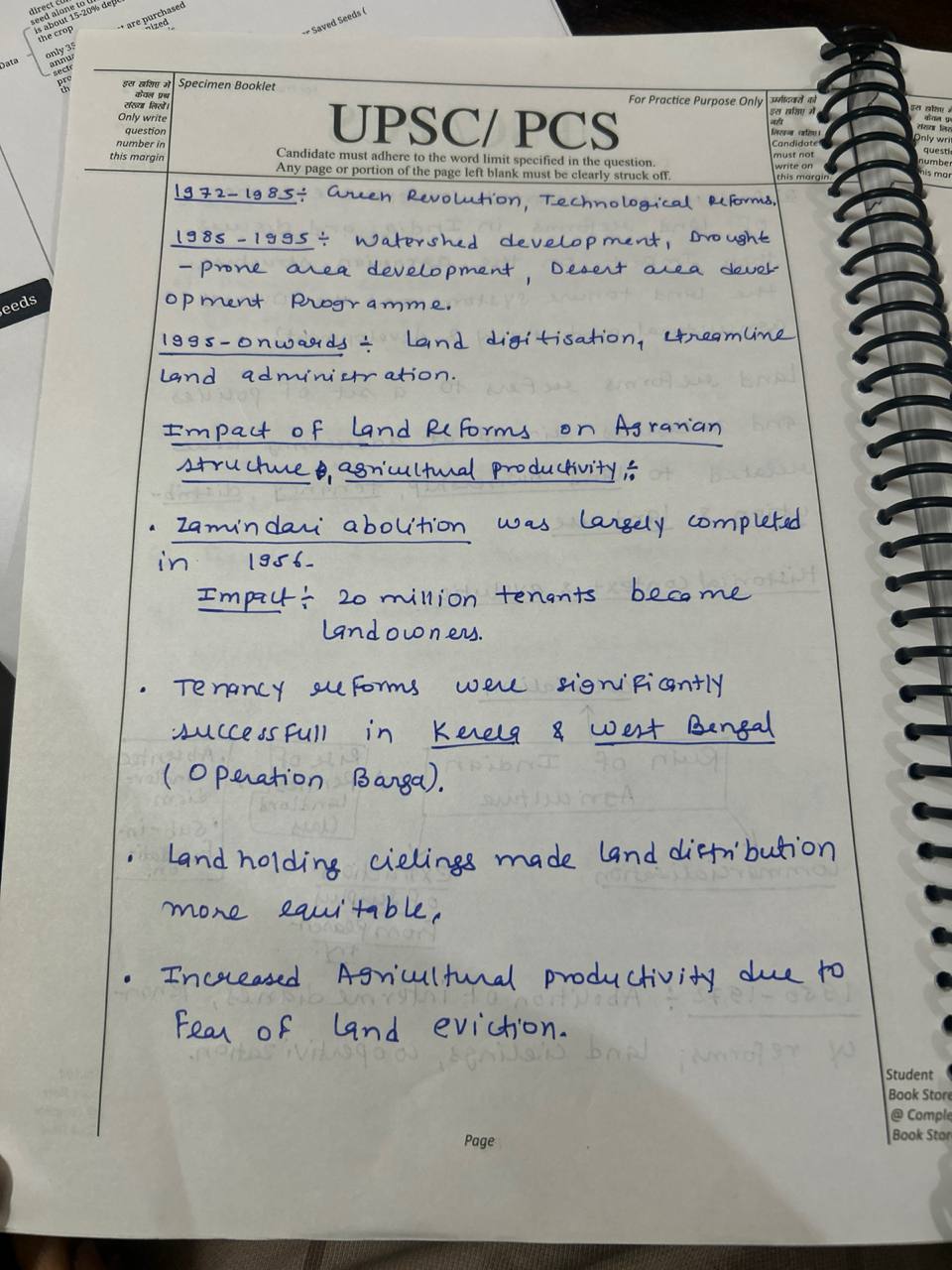The Kerala model highlights an economy with spectacular developments in the social sector without having a good economic backup. Land reform was undertaken more effectively in Kerala. Land reform in kerala imparted drastic changes to the economic outlook.
Model Answer Introduction Land reforms have been crucial in India's agrarian history, aimed at promoting social justice and economic development. Implemented post-independence, these reforms sought to rectify socio-economic disparities caused by historical land ownership patterns. Objectives of LandRead more
Model Answer
Introduction
Land reforms have been crucial in India’s agrarian history, aimed at promoting social justice and economic development. Implemented post-independence, these reforms sought to rectify socio-economic disparities caused by historical land ownership patterns.
Objectives of Land Reforms in India
- Abolition of Intermediaries:
- Eliminate zamindars and other intermediaries who exploited peasants. This aimed to connect the state directly with the tillers.
- Tenancy Regulation:
- Provide security to tenants against eviction and ensure fair rent practices, protecting the rights of those who cultivate the land.
- Redistribution of Land:
- Achieve a more equitable distribution of land and eliminate large landholdings, thereby benefiting the landless and small farmers.
- Land Consolidation:
- Amalgamate fragmented farms into compact units for efficient farming, enhancing agricultural productivity.
- Agrarian Administration:
- Introduce effective management and administrative measures for agricultural land to streamline operations.
Measures of Land Reforms
- Abolition of Zamindari System:
- Various state acts were passed to abolish zamindars, vesting land titles directly with the state, benefiting millions of peasants.
- Fixation of Land Ceilings:
- Laws were enacted to set maximum landholding limits. Surplus lands were taken by the state and redistributed among the landless.
- Tenancy Laws:
- Implemented to provide security of tenure, fair rent fixation, and ownership rights to tenants in various states.
- Consolidation of Holdings:
- Efforts were made to reduce land fragmentation and create unified holdings for better management.
- Cooperative Farming:
- Encouraged smallholders to pool resources for cooperative farming, enhancing productivity.
Land Ceiling as an Effective Economic Reform
- Reduction in Inequalities: Redistributing surplus land helps reduce economic disparities and provides livelihoods to vulnerable populations.
- Enhanced Productivity: Smaller farms typically achieve higher productivity per unit of land. For instance, in states like West Bengal and Kerala, comprehensive land reforms led to improved agricultural productivity.
- Economic Empowerment: Land ownership serves as collateral, enabling farmers to access credit and invest in better technologies.
- Diversified Agriculture: Secure land rights encourage farmers to invest in long-term crops and diversify their practices.
In conclusion, land reforms, particularly the land ceiling policy, have transformed India’s agrarian landscape, addressing historical injustices while promoting a more inclusive agricultural economy.
See less



The Land Reform Act in Kerala played a crucial role in shaping the state's economic and social landscape, contributing significantly to what is known as the "Kerala Model of Development." Here are the key impacts of the Land Reform Act on the Kerala Model of Economics: 1.Redistribution of Land: TheRead more
The Land Reform Act in Kerala played a crucial role in shaping the state’s economic and social landscape, contributing significantly to what is known as the “Kerala Model of Development.” Here are the key impacts of the Land Reform Act on the Kerala Model of Economics:
1.Redistribution of Land:
The Land Reform Act aimed to redistribute land from large landowners (often landlords) to landless agricultural laborers and poor farmers. This redistribution helped in reducing land inequality and creating a more equitable distribution of agricultural resources.
2.Improvement in Agricultural Productivity:
By redistributing land to small farmers and agricultural laborers who previously had limited access to land, the Land Reform Act contributed to an increase in agricultural productivity. Small farmers typically cultivate land more intensively and are motivated to invest in improving productivity.
3.Poverty Reduction:
The Land Reform Act played a role in reducing poverty in Kerala by providing land to landless laborers and farmers, thereby enabling them to generate income from agricultural activities. This increased economic opportunities and improved living standards for many rural households.
4.Social Justice and Empowerment:
The Act promoted social justice by addressing historical injustices related to land ownership. It empowered marginalized communities, including Dalits and other lower castes, by giving them access to land and thus enhancing their socio-economic status.
5.Support for Welfare Measures:
The land reforms complemented Kerala’s focus on social welfare measures such as education, healthcare, and social security. Land ownership provided a base for rural households to participate more actively in development programs and benefit from public services.
6.Role in Human Development Indices:
The equitable distribution of land contributed to Kerala achieving high levels of human development, as evidenced by its high literacy rates, life expectancy, and low infant mortality rates. Land ownership provided a foundation for rural families to invest in education and healthcare for their children.
7.Political Impact:
The implementation of land reforms in Kerala was supported by a politically active population and progressive governments. This political will to enforce and protect land reforms contributed to their success and sustained impact on the state’s development model.
In essence, the Land Reform Act in Kerala was a cornerstone of the state’s economic development strategy, promoting agrarian reforms, reducing inequality, empowering marginalized communities, and contributing to overall human development. It played a pivotal role in shaping the unique socio-economic framework known as the Kerala Model of Economics, which emphasizes social welfare, equitable development, and human development indices alongside economic growth.
See less